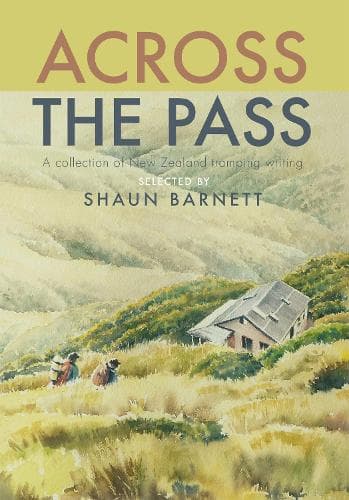Review: Across the Pass: A collection of New Zealand tramping writing
Reviewed by Alison Ballance
I’ve always thought of tramping as a distinctly New Zealand term for a recreational activity the rest of the world refer to as hiking, rambling, bushwalking or trekking. But while that is true, outdoor writer and editor Shaun Barnett explains that it derives from the German ‘trampen,’ which literally means ‘to walk heavily’ and that it was commonly used in the “late 1800s and early 1900s to describe everything from soldiers marching, horses trotting, prospectors prowling and even dancers stomping.”
While I didn’t come across dancers or soldiers in Across the Pass – a collection of New Zealand tramping writing, I did spend wonderful time in the company of a wide range of people, from poets and writers to engineers, teachers and photographers — and even a bot, in a piece by Barnett in which he imagines tramping in the not-too-distant future.
He has selected 100 pieces of writing that explore the experience of tramping in New Zealand. He begins the book by describing tramping as a journey and goes on to say that his “discovery of tramping literature has been a pathway, too – one that began in ignorance.” I suspect that most readers, myself included, will share that sentiment and will be similarly delighted and impressed by the breadth of creative writing that Barnett has selected, which includes a number of poems. The works span 1842 to 2021 and while the writers range from famous to unknown, what they share is a love of the outdoors and for walking while carrying life’s necessities on one’s back.
The book is curated into six parts: Footprints, Stuffing packs and making tracks, Under canvas or corrugated iron, Through the bush and mountains, Companions and The tramping experience. There are thoughtful reflections, humour and comedy, desperate plights, epic tales, warm companionship and wise words from those who learnt the hard way. There are vistas that go on forever and rain-soaked visibility that goes no further than an outstretched arm. There are days passing through tussock and forest, up and down gnarly rivers and steep scree slopes, nursing sore knees and trying to hide from the sun. Nights are spent under corrugated iron, canvas, nylon and just the stars, battling sandflies, hard ground, snoring and kea. The chosen offerings are rich and diverse.
Nelsonian Ray Salisbury describes a typical hut evening: “If you’re the first to arrive at a hut, you have the privilege of bagging a bunk, or boiling a billy for late arrivals. Firewood may need gathering, and water collected from a nearby stream. And, in timeless tradition, the hut’s logbook, usually green, will be read, laughed at, and added to. Candles lit, games played, or books read.”
Veteran tramping writer Geoff Spearpoint offers camping advice: “I always choose campsites tucked under a bush fringe whenever I can. There are many advantages. Trees are like a roof. On a fine night they keep most of the dew off my sleeping bag or the tent. They also keep the cold at a distance.”
The late Sheila Natusch was a naturalist who walked with her eye to the ground in search of beauty: “It was heavy going, but there was always the chance of finding one of the big sundews with tall stems and slender forked leaves that have red hairs terminating in a sticky drop of clear liquid, a trap for insects. Usually there are several half-assimilated corpses clinging to the stems.”
Historian Barry Brailsford reflects on Māori trail lore: “Trail breaking was the task of the leader who marked the path for future parties by snapping, but not severing, small branches along the way. The snapping was known as kowata or whati, and the route marking as ara pawhati … [and] where Māori trails led over moss the moss never sprang back into its former shape. The pathway could thus be felt by the feet even though the moss looked little different to the eye.”
Wellingtonian Bill Nelson talks about conversation in the hills: “Tramping is not about walking. For a lot of people it is just as much about talking while they are walking. Also talking between walking and talking while falling, stumbling, sliding, puffing.”
Pioneering journalist Elsie Morton recollects a night alone in the rundown shelter on Milford Track’s Mackinnon Pass: “It had no doubt been a snug-enough little parking place in its day, but obviously that day had passed some time since. The prospect of Fiordland Fun by night seemed to take on new possibilities as the evening wind moaned and whistled, the roof creaked, and the keas practised their grand slaloms down its dilapidated sides with raucous yells.”
Across the Pass is a most satisfying book that will provide inspiration to wannabe and long-time trampers alike. It is like having the most erudite outdoor companion in your home and will offer solace for those for those moments when you really want to be out tramping but for whatever reason can’t.
Reviewed by Alison Ballance
